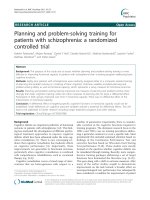programming and problem solving with c++ 6th by dale ch14
Bạn đang xem bản rút gọn của tài liệu. Xem và tải ngay bản đầy đủ của tài liệu tại đây (727.08 KB, 137 trang )
Chapter 14
Dynamic Data and
Linked Lists
Chapter 14 Topics
Meaning of a Linked List
Meaning of a Dynamic Linked List
Traversal, Insertion and Deletion of
Elements in a Dynamic Linked List
Specification of a Dynamic Linked Sorted
List
Insertion and Deletion of Elements in a
Dynamic Linked Sorted List
Chapter 14 Topics
Meaning of an Inaccessible Object
Meaning of a Dangling Pointer
Use of a Class Destructor
Shallow Copy vs. Deep Copy of Class
Objects
Use of a Copy Constructor
What is a List?
A list is a varying-length, linear
collection of homogeneous elements
Linear means:
Each list element (except the first) has a
unique predecessor, and
Each element (except the last) has a
unique successor
To implement the List ADT
The programmer must:
1) choose a concrete data
representation for the list, and
2) implement the list operations
Recall:
4 Basic Kinds of ADT Operations
Constructors -- create a new instance (object)
of an ADT
Transformers -- change the state of one or
more of the data values of an instance
Recall: 4 Basic Kinds of ADT
Operations
Observers -- allow client to observe
the state of one or more of the data
values of an instance without
changing them
Iterators -- allow client to access the
data values in sequence
List Operations
Transformers
Insert
Delete
change state
Sort
Observers
IsEmpty
IsFull
Length
IsPresent
observe state
ADT List Operations
Iterator
Reset
GetNextItem
Iteration Pair
Reset prepares for the iteration
GetNextItem returns the next item in
sequence
No transformer can be called between calls
to GetNextItem (Why?)
Array-based class List
SelSort
IsEmpty
IsFull
Length
Insert
Private data:
length
data
0]
[1]
[2]
[
Delete
IsPresent
Reset
GetNexItem
[MAX_LENGTH-1]
currentPos
// Specification file arraybased list (“list.h”)
const int MAX_LENGTH = 50;
typedef int ItemType;
class List // Declares a class data type
{
public: // Public member functions
List(); // constructor
bool IsEmpty () const;
bool IsFull () const;
int Length () const; // Returns length of list
void Insert (ItemType item);
void Delete (ItemType item);
bool IsPresent(ItemType item) const;
void SelSort ();
void Reset ();
ItemType GetNextItem ();
private: // Private data members
int length; // Number of values currently stored
ItemType data[MAX_LENGTH];
int CurrentPos; // Used in iteration
};
Implementation Structures
Use a built-in array stored in contiguous
memory locations, implementing operations
Insert and Delete by moving list items around
in the array, as needed
Use a linked list in which items are not
necessarily stored in contiguous memory
locations
A linked list avoids excessive data movement
from insertions and deletions
Implementation
Possibilities for a List ADT
List
Built-in array
Linked list
Built-in
dynamic data
and pointers
Built-in array
of structs
A Linked List
A linked list is a list in which the order
of the components is determined by an
explicit link member in each node
Each node is a struct containing a
data member and a link member that
gives the location of the next node in
the list
head
‘X’
‘C’
‘L’
Dynamic Linked List
A dynamic linked list is one in which the
nodes are linked together by pointers and
an external pointer (or head pointer) points
to the first node in the list
head
“Ted”
“Irv”
“Lee”
Nodes can be located anywhere
in memory
The link member holds the memory
address of the next node in the list
3000
head 3000
“Ted” 5000
5000
“Irv” 2000
2000
“Lee” NULL
Declarations for a
Dynamic Linked List
// Type declarations
struct NodeType
{
char info;
NodeType* link;
}
typedef NodeType* NodePtr;
// Variable DECLARATIONS
NodePtr head;
NodePtr ptr;
‘A’
. info
6000
. link
Pointer Dereferencing
and Member Selection
ptr
‘A’
. info
ptr
‘A’
. info
6000
. link
ptr
‘A’
. info
6000
. link
ptr
*ptr
(*ptr).info
ptr->info
6000
. link
ptr is a pointer to a node
ptr
‘A’
. info
ptr
6000
. link
*ptr is the entire node
pointed to by ptr
ptr
‘A’
. info
*ptr
6000
. link
ptr->info
is a node member
ptr
‘A’
. info
6000
. link
ptr->info
(*ptr).info
// Equivalent
ptr->link
is a node member
ptr
‘A’
. info
6000
. link
ptr->link
(*ptr).link
// Equivalent
Traversing a
Dynamic Linked List
ptr
3000
head 3000
“Ted” 5000
5000
“Irv” 2000
2000
“Lee” NULL
// Pre: head points to a dynamic linked list
ptr = head;
while (ptr != NULL)
{
cout << ptr>info;
// Or, do something else with node *ptr
ptr = ptr>link;
}
Traversing a
Dynamic Linked List
ptr
3000
3000
head 3000
“Ted” 5000
5000
“Irv” 2000
2000
“Lee” NULL
// Pre: head points to a dynamic linked list
ptr = head;
while (ptr != NULL)
{
cout << ptr>info;
// Or, do something else with node *ptr
ptr = ptr>link;
}









